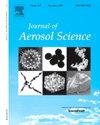Atmospheric implications of fumaric acid - Water binary clusters
IF 3.9
3区 环境科学与生态学
Q2 ENGINEERING, CHEMICAL
引用次数: 0
Abstract
Fumaric acid (FA) is amongst the most abundant low molecular-weight dicarboxylic acids in the atmosphere and is present in atmospheric aerosols. However, the climate implications of fumaric acid in the presence of water (W) are not yet known. In the present study, the structures and thermodynamics of the most stable isomers of FA(H2O)n (n = 1–10) are investigated using APF-D/6-311+G(d, p) and benchmarked with ωB97X-D/6–311++G(3df,3pd). The atmospheric abundance and IR spectra of these complexes are calculated alongside the use of the narrow-band model (NBM) to estimate the radiative forcing efficiencies (RE) of hydrates. Optical properties such as Rayleigh light scattering intensities for natural and polarized light were then calculated. The clusters FA(H2O)n are held together by strong hydrogen bonds formed between the water molecules and the carboxylic acid functional group. The binding free energies of the most stable clusters of n = 1–5 are negative and decrease with cluster size while for n = 6–10, they are positive. Cluster concentration decreases with relative humidity (RH) with the smaller clusters dominating at all investigated RH. These clusters show high evaporation rates at 298K and 1atm. Also, the radiative forcing efficiencies of FA(H2O)n = 1-10 are positive and increase with cluster size. This major part of the radiative forcing occurs within the atmospheric window region 250–1500 cm−1. Analysis of the Rayleigh scattering properties showed that the Rayleigh scattering intensity is enhanced upon the increase of the number of water molecules in the cluster. Therefore in the atmosphere, FA(H2O)n = 1-10 induces a scattering which reduces its overall heating effect on the earth.

富马酸-水二元星团的大气意义
富马酸(FA)是大气中含量最丰富的低分子量二羧酸之一,存在于大气气溶胶中。然而,富马酸在水(W)存在下对气候的影响尚不清楚。在本研究中,用APF-D/6-311+G(d, p)和ωB97X-D/ 6-311+ +G(3df,3pd)表征了FA(H2O)n (n = 1-10)最稳定的异构体的结构和热力学。利用窄带模式(NBM)估算水合物的辐射强迫效率(RE),计算了这些配合物的大气丰度和红外光谱。然后计算了自然光和偏振光的瑞利光散射强度等光学特性。FA(H2O)n是由水分子和羧酸官能团之间形成的强氢键结合在一起的。当n = 1 ~ 5时,最稳定团簇的束缚自由能为负,随团簇大小的增大而减小,而当n = 6 ~ 10时,束缚自由能为正。簇浓度随相对湿度(RH)的增加而降低,较小的簇在所有研究的RH中占主导地位。这些团簇在298K和1atm时显示出较高的蒸发速率。FA(H2O)n = 1 ~ 10的辐射强迫效率为正,且随簇的大小而增加。这主要部分的辐射强迫发生在250-1500 cm−1的大气窗口区。瑞利散射特性分析表明,随着团簇中水分子数量的增加,瑞利散射强度增强。因此,在大气中,FA(H2O)n = 1-10引起散射,从而降低其对地球的总体加热效应。
本文章由计算机程序翻译,如有差异,请以英文原文为准。
求助全文
约1分钟内获得全文
求助全文
来源期刊

Journal of Aerosol Science
环境科学-工程:化工
CiteScore
8.80
自引率
8.90%
发文量
127
审稿时长
35 days
期刊介绍:
Founded in 1970, the Journal of Aerosol Science considers itself the prime vehicle for the publication of original work as well as reviews related to fundamental and applied aerosol research, as well as aerosol instrumentation. Its content is directed at scientists working in engineering disciplines, as well as physics, chemistry, and environmental sciences.
The editors welcome submissions of papers describing recent experimental, numerical, and theoretical research related to the following topics:
1. Fundamental Aerosol Science.
2. Applied Aerosol Science.
3. Instrumentation & Measurement Methods.
 求助内容:
求助内容: 应助结果提醒方式:
应助结果提醒方式:


